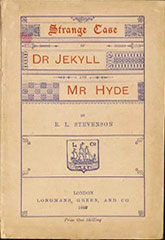Strange Case of Dr Jekyll and Mr Hyde
Critique • Quotes • Text • At the movies
 First edition
First editionFirst publication
1886
Literature form
Novella
Genres
Literary, science fiction, horror
Writing language
English
Author's country
Scotland
Length
Approx. 24,500 words

Spencer Tracy is a low-key Jekyll with Ingrid Bergman's barmaid, but he bounces off the walls as Hyde.
Dr. Jekyll takes it easy
Dr. Jekyll and Mr. Hyde (1941): Film, 127 minutes; director Victor Fleming; writer John Lee Mahin; featuring Spencer Tracy, Ingrid Bergman, Lana Turner
The 1931 film was so successful, it was essentially remade ten years later.
But the 1941 Dr. Jekyll and Mr. Hyde, despite following its predecessor closely, feels different because Spencer Tracy is not the actor that Fredric March is. He's much better, in my opinion, but miscast in this role.
Tracy's Jekyll is so low-key, so much like the priests and pals Tracy normally plays, that it's hard to see the inner fire that drives the doctor. He's motivated by the desire to cure the insane, people whose good side has been taken over by the bad.

 Tracy comes somewhat alive as Hyde
though. After some awkward transformations through time-lapse photography,
his villainous character is closer to Barrymore's than March's. He looks
like Tracy's sleazier, older brother, with bushier eyebrows and darker
complexion, but mainly achieving his effect through maniacally gleaming
eyes and energetic body language.
Tracy comes somewhat alive as Hyde
though. After some awkward transformations through time-lapse photography,
his villainous character is closer to Barrymore's than March's. He looks
like Tracy's sleazier, older brother, with bushier eyebrows and darker
complexion, but mainly achieving his effect through maniacally gleaming
eyes and energetic body language.
He's quietly chilling, not in a horror movie way but more like the trusted friend you discover is capable of doing dreadful things.
The same love interests are back, this time named Beatrix and Ivy. The roles are played by Ingrid Bergman and Lana Turner, no less. But here's the catch: Hollywood sex goddess Turner plays against type as the virginal fiancée Beatrix, while the esteemed Bergman takes the lesser role of the saucy barmaid Ivy. And Bergman is radiant, just about stealing the film. You root for her to catch Jekyll's heart.
Many of the scenes play almost identically as in the 1931 film, with similar sets. I'm not sure why the former screenwriters and playwright were not credited.
Hyde even does some of the same acrobatics as in the earlier film, jumping over banisters and bouncing off walls—though I detect the work of stuntmen this time.
And the good doctor's name is now pronounced JECK-ul, though one character does call him JAY-kul.
By the way, watch for Brandon Hurst, the tempter in the 1920 Barrymore film, in an uncredited appearance as a butler in this movie.
— Eric

